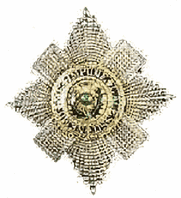Sovereign and sixteen knights and ladies
The Order of the Thistle consists of the sovereign and sixteen knights and ladies, as well as extra knights. The Order's emblem is the thistle, the traditional national flower of Scotland. The patron saint of the order is St. Andrew and its motto is Nemo me impune lacessit (No one provokes me with impunity) It is the second most senior order of chivalry in Britain and the highest in Scotland.
The foundation date of the Order lies obscured by the mists of time. Legend states that in 809 the Celtic King Achaius gave the Order to the Emperor Charlemagne. Charlemagne was known to employ Scottish bodyguards but most consider the exchange to be a gift. Reference to an Order of the Thistle occurs again when James II, King of Scots bestowed the “Order of the Burr or Thissil” on King Francis I of France in the fifteenth century but again there is little evidence to support this Some accounts credit it as being founded on the battlefield of Bannockburn by the great Robert the Bruce. Others claim it was established by James V in 1540.
James II issued letters patent " reviving and restoring the Order of the Thistle to its full glory, lustre and magnificency" in 1687. His daughter, the last Stuart monarch, Queen Anne, revived it again in 1703. The Chapel of the Order was the Abbey Church at the Palace of Holyrood House, After the destruction of this chapel during riots, for many years the Order possessed none until one was added to St. Giles High Kirk, Edinburgh in 1911.
Every year, the monarch resides at the Palace of Holyrood Palace, located at the bottom of the Royal Mile in Edinburgh, for a week in June or July. During this time, a service for the Order is held where the knights of the order wear their ceremonial robes of deep green. Any new Knights or Ladies are installed at these services. Each member of the Order, including the Sovereign, is allotted a stall St. Giles Kirk, above which his or her heraldic devices are displayed.
Occasionally, members can be admitted to the Order by special statutes. These members are known as "Extra Knights" and do not count towards the sixteen-member limit. Members of the British Royal Family are normally admitted in this way, the first of which was Prince William Henry, the third son of George III who later became King William IV. The only foreigner ever admitted to the order has been King Olaf V of Norway (1903-91), who was the son of Princess Maud of Wales and therefore a grandson of Edward VII. His appointment took place in 1962.
The Order of the Thistle.
Vestments of the Order
The order's cloak is green lined with white taffeta, with green and gold tassels. The star is worn on the left shoulder, the hat is black with white osprey feathers. The badge of the Order of the Thistle, St. Andrew is hung from a gold collar, it bears a gold enamelled picture of St. Andrew, wearing a green gown and purple cloak and holding a white saltire.
The star of the Order of the Thistle is silver, with St. Andrew's saltire and clusters of rays. In the centre is a green circle bearing the motto in gold, inside the circle is a thistle on a gold background. The star is worn pinned to the left side of the chest. A dark green sash is worn across the body from the left shoulder to the right hip. The badge of the order is attached to a ribbon on the right hip. On its adverse side, St. Andrew is depicted, on the reverse, a thistle on a green ground surrounded with the motto.
